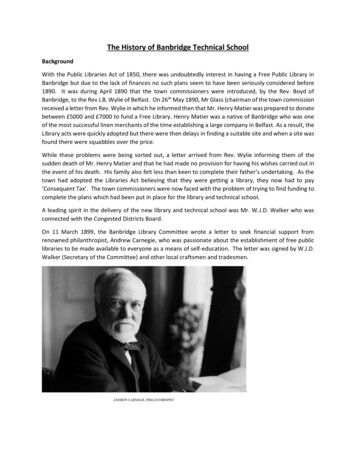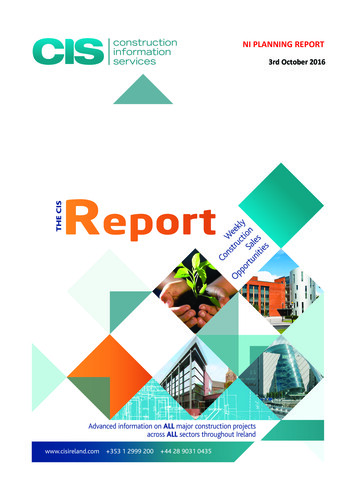
Transcription
The History of Banbridge Technical SchoolBackgroundWith the Public Libraries Act of 1850, there was undoubtedly interest in having a Free Public Library inBanbridge but due to the lack of finances no such plans seem to have been seriously considered before1890. It was during April 1890 that the town commissioners were introduced, by the Rev. Boyd ofBanbridge, to the Rev J.B. Wylie of Belfast. On 26th May 1890, Mr Glass (chairman of the town commissionreceived a letter from Rev. Wylie in which he informed then that Mr. Henry Matier was prepared to donatebetween 5000 and 7000 to fund a Free Library. Henry Matier was a native of Banbridge who was oneof the most successful linen merchants of the time establishing a large company in Belfast. As a result, theLibrary acts were quickly adopted but there were then delays in finding a suitable site and when a site wasfound there were squabbles over the price.While these problems were being sorted out, a letter arrived from Rev. Wylie informing them of thesudden death of Mr. Henry Matier and that he had made no provision for having his wishes carried out inthe event of his death. His family also felt less than keen to complete their father’s undertaking. As thetown had adopted the Libraries Act believing that they were getting a library, they now had to pay‘Consequent Tax’. The town commissioners were now faced with the problem of trying to find funding tocomplete the plans which had been put in place for the library and technical school.A leading spirit in the delivery of the new library and technical school was Mr. W.J.D. Walker who wasconnected with the Congested Districts Board.On 11 March 1899, the Banbridge Library Committee wrote a letter to seek financial support fromrenowned philanthropist, Andrew Carnegie, who was passionate about the establishment of free publiclibraries to be made available to everyone as a means of self-education. The letter was signed by W.J.D.Walker (Secretary of the Committee) and other local craftsmen and tradesmen.
Mr. Carnegie agreed to provide 1,000 to the building of a library providing a free site could be found anda satisfactory design of the building produced. In May 1899, the library committee were able to state toCarnegie that they had a ‘Firm Offer’, on paper, of the best and most central site in Banbridge for theproposed free library’ and that they had raised 700 locally toward the new building.The site was purchased from the Trustees of the First Presbyterian Church for 165.The architect appointed in 1901 was a Mr Henry Hobart and the materials used were red bricks andterracotta from the LaganVale brickworks. The contractor for the building was a Mr. John Graham fromDromore. The original building cost 1246.Henry Hobart - ArchitectIn 1902, Banbridge Urban Council appointed a Technical Instruction Committee. In an article published inthe Irish News and Belfast Morning News (11 July 1902), it was reported that on behalf of the ProvisionalLibrary Committee, Mr. W.J.D. Walker, would hand in a statement of accounts and the Urban CouncilLibrary and Technical Instruction Committee could take over the entire control of the business.Mr. Carnegie was invited to attend the opening of the Free Library but did not attend, possibly becausehe was not pleased that the library plans had by this stage incorporated a technical school in the building.
1902Opening of the Banbridge Free Library and Technical School, Downshire Road, BanbridgeThe library was opened with a series of lectures held on the 28thand 29th September and from 1st-3rdOctober 1902. The last lecture started with a vote of thanks to all those who had subscribed to thebuilding with a special mention of Mr. Carnegie who had given ‘ 1000 to people he had never seen.’ Thelectures were conducted by the secretary of the committee, Mr W.J.D. Walker, and involved a lengthyexamination of various items and diseases viewed under the microscope. References were made toamong others, beehives, potato blight, tetanus, lockjaw, typhoid and consumption. The lecture concludedwith Mr. Walker handing over the keys to Mr. James McIlroy, chairman of the Urban Council saying, ‘theLibrary ship is launched; it is for you to select the crew.’ The latter then thanked Mr Walker on behalf ofthe council and the public at large. A vote of thanks was given to the library committee and especially MrWalker for three years work which had culminated in ‘this beautiful building.’ The series of lectures duringthe opening week of the Free Library and Technical School saw attendances of over 1,400 people, whichfor a town with a population of 5,600 surely reflects the outstanding support of the community.Mr. Brice Moore BA LLB was appointed Principal and Secretary in 1902.It is likely that the first floor was the only part of the building used for library purposes, as the three roomson the ground floor were let by the Library Committee to the Technical Instruction Committee almost assoon as the building was opened.Subjects offered in these early years of the Technical School included Drawing - Freehand Model andGeometrical, Manual Instruction, Cookery, Laundry, Dressmaking and Needlework, Shorthand andBookkeeping.In 1907-08, the total number of students was 268.
1910The school enlarged and close cooperation between the industrial employers and the schoolcommenced. The entrance, through the annexe, was provided in 1910 by Mr. N.D. Ferguson andMr. T.S. Ferguson who were members of a well-known local family. This was known as the“Ferguson Annexe”.T.S. Ferguson1919The cooperation between the industries and the school intensified and an employers’ committeewas formed to supervise the training of all apprentices and skilled trades. As a result, it becamenecessary for a workshop to be provided.The continued development of the school, and the growing needs of the secondary school, thenin daily occupation of the premises, necessitated a further extension and from 1923 efforts werecontinuously made to obtain a solution to the financial difficulties of the school.In 1922-23, the total number of students was 562.1926A solution was not found until 1926 when the Regional Committee undertook to enlarge thepremises in February 1926. In April 1926, the school was transferred to the Regional Committeeof Down and its activities were immediately extended by the Director of Education in the county.
Instead of thinking of the interests of one school in Banbridge, they now had to consider the claimsof Dromore, Hillsborough, Moira, Gilford and a large rural population. They could as aconsequence utilise the services of highly expert teachers more advantageously than before, andin many other ways the good work of technical education could be enhanced.The plot of ground on the South side of the site was presented to the Library Committee by theDirectors of the G.N. Railway as a free gift. This was of great importance as it permitted a furtherextension of the Technical School when the occasion required it.1927Extension to Technical School OpenedThe extension to the Technical School was formally opened on 31 August 1927 by ViscountBangor, Chairman of County Down Regional Committee. It was reported in the Belfast Newsletter(1 Sept 1927) that the new buildings provided much additional accommodation and, in design andconstruction, harmonised with the older part of the school. On the ground floor, there was aspacious assembly hall, and on the upper stories were kitchens, storerooms, classrooms and ascience laboratory. A new workshop was built as well as a textile room for the use of thosestudying linen manufacture. Adjoining the building was a recreation ground with facilities forhockey and tennis.The building served a treble purpose as it housed a secondary school in the day time, enabledcentral classes in domestic economy and woodwork from pupils from public elementary schoolsto be carried on, and at night the technical school was accommodated. The technical schoolserved the town and the rural area within a 5-mile radius.The official opening ceremony took place in the assembly hall. During the official opening,Viscount Bangor was reported to have said that the benefits of technical education to amanufacturing district could hardly be over-estimated, and it was a great matter that employershad realised that fact and were giving employees every help to attend the classes. The moneyand time expended in the erection of the Banbridge Technical School would, he was sure, beamply repaid in the future. The building housed a very flourishing technical school, and he wouldlike to see this principal of dual accommodation adopted in other parts of the county, because ittended to the economy and efficiency in many ways.In 1926-27, the total number of students was 613.
1954The Belfast Newsletter (23 April 1954) reported that the Down County Health Committee inBelfast were going to start negotiations with the County Education Committee for the acquisitionof Banbridge Technical School. Mr. J. Partridge, secretary for the Health Committee, said that thepremises would be suitable for use as clinics as he had heard that the Education Committee weregoing to build a new technical school.1961 (circa)Construction of New Technical College – Castlewellan RoadArchitect: R. Ferguson and S. McIlveen, College Gardens, BelfastPhotographer: Effie McMeekin
1962Opening of New Banbridge Technical College – Castlewellan Road1982In September 1982, Banbridge Technical College saw the reopening of the Old Tech inthe Downshire Road as a venue to host classes as space was obviously an issue duringthis period. In that year it was reported in the school magazine, that “Gone are the dayswhen it was necessary to hold Biology classes in the boys’ changing rooms and learn thedelicate act of boiling eggs in car radiators as cookery classes were held in the CarMaintenance Bay.”Sept 1994Upper Bann Institute is established as a result of the amalgamation of BanbridgeTechnical College with further education colleges in Lurgan and Portadown.Oct 1997Education Minister Tony Worthington officially opened the 130,000 media suite atthe Upper Bann Institute – Banbridge Campus to become one of the leading centres formedia and journalism studies in Northern Ireland.
April 1998Upper Bann Institute becomes an incorporated college - a free-standing organisationresponsible for its own personnel and curriculum affairs and no longer subject to thecontrol of the Southern Education and Library Board.Sept 2007Southern Regional College is established via the merger of Upper Bann Institute ofFurther and Higher Education, Armagh College and Newry and Kilkeel Institute ofFurther and Higher Education.Sept 2020Southern Regional College will open its new 15m state of the art campus.
Credits:Mr Matt Bankhead – ResearcherBanbridge LibraryF.E. McWilliam Gallery and Studio, Banbridge
The History of Banbridge Technical School Background With the Public Libraries Act of 1850, there was undoubtedly interest in having a Free Public Library in Banbridge but due to the lack of finances no such plans seem to have been seriously considered before 1890. It was during April 1890 that the town commissioners were introduced, by the Rev .










